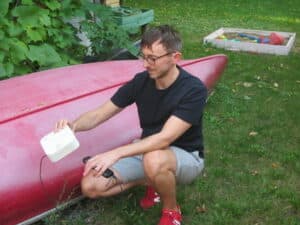Field Notes from a Citizen Scientist
 By Stephan Telka, Volunteer and Citizen Scientist, with Sierra Club Ontario
By Stephan Telka, Volunteer and Citizen Scientist, with Sierra Club Ontario
I live a few hundred metres from the Queensway in Ottawa, and have long wondered about the air quality in the neighbourhood. Is my proximity to the highway and a major feeder road bad for my health? Ottawa is quite green, but is the air quality okay? After reading about the Breathe Easy campaign in an Ottawa Citizen article, I put my hand up to get involved.
After a quick tutorial by the friendly local coordinator, Jake Cole, I set out to take some readings, and made a few observations along the way:
- Closing the windows and using A/C during forest fire season made a noticeable difference in air quality: I got the Air Quality Egg as news of the BC and Northern Ontario forest fires made headlines, and a day or two after an official “air quality advisory” had been lifted in Ottawa. However, the air quality still seemed bad outside. Unfortunately, there doesn’t appear to be a ‘safe’ level of fine particulate matter (i.e. PM2.5), a common air pollutant and the focus of the Breathe Easy program. Like all air pollution though, lower values are better and mean cleaner air. My initial outdoor readings over the course of three days ranged from 24.3 PM2.5 (measured in μg/m3) on my front steps, to 20.7 PM2.5 on my balcony. However, inside my well-sealed, air-conditioned home, with pretty basic air filters, the air quality ranged from 2.55 to 8.12 PM2.5.
- Air purifiers do make a difference: Chatting over dinner with a friend who lives in a heritage apartment building nearby, she shared that she had also been wondering about air quality in her place, particularly given she has neighbours who smoke indoors on the floor below her. She typically used an air purifier when she was home, but wondered whether it actually worked and made a difference. Over those same three days when the effects of the forest fires were still blowing through Ottawa, she closed the windows (but had a window-mounted A/C), and her PM2.5 measurements ranged from 38 to 40. Turning on the air purifier brought the readings down to a range of 6.7 to 18 PM2.5. A few lessons she learned were to: 1) keep the air purifier on longer during the day and; 2) make sure the purifier had the capacity to filter the air in her spacious apartment. In her case, she ended up buying a second device.
- Kitchen exhaust fans also make a difference: My friend in the heritage apartment is an avid cook, but her older apartment doesn’t have an exhaust fan in the kitchen – she wondered whether it made a difference to her air quality. While going down a rabbit hole online about air quality measurement and factors, she accidentally let a piece of toast burn in the kitchen. With the windows closed, she got a measurement of 131 PM2.5! She had no idea cooking could affect indoor air quality so much. She’s now making it a point to open the window while cooking, and turn on the exhaust fan while cooking at others’ places.
- Physical proximity to a busy highway or major roadway can mean bad air quality: A few days later, I offered to do some readings at another friend’s place, whose house faces the Queensway, only separated by a sound barrier and a parkette. It was admittedly a Sunday evening, so likely the quietest time of the week for highway traffic, and admittedly only one point in time. I got readings between 13.6 and 14.2 PM2.5 on her front steps, 13.2 to 13.5 PM2.5 in her backyard. Meanwhile a few blocks away, measurements at my place were as high as 15.5 PM2.5 on my roof, leading me to believe that the barrier in front of her house protected her space, while the winds blew emissions in my direction. Readings at another friend’s place on a busy secondary road (Riverdale) clocked in at 14.9 PM2.5. These findings may not sound too alarming in isolation. However, we know that proximity to major roadways (both highways and secondary roads) can expose residents to higher levels of air pollution relative to the general population, including PM2.5. Long-term exposure can lead to a range of health problems. Of course, I would need more time with the Egg to help determine the long-term level of risk to traffic-related air pollution for me and my friends.
- People are interested in the air they’re breathing. Borrowing the machine from Breathe Easy was certainly a conversation starter, and got me and my friends talking. Many more people in my circles are curious about air quality, but not quite sure how to get data, and moreover, not quite sure how to affect change. What kind of personal actions will lead to the greatest change? Is buying an electric vehicle really the best answer? Air purifiers are helping my friend in the heritage apartment, but what about those who can’t afford to run an air purifier all day, or buy one in the first place? One of the goals of Breathe Easy is to equip residents with knowledge of how they can reduce their contribution to air pollution on an individual level. They’re also reaching out to the local government to advocate for policy changes that will reduce air pollution at a collective level, to ensure clean air for all.
______________________________________________________________________________
Stephan is a civil servant in Ottawa. He has long been interested in environmental causes, helping in small ways to ban pesticide use in Peterborough and to ban indoor smoking in Kingston. He is currently a citizen scientist with Sierra Club Ontario’s Breathe Easy campaign.
Make sure to follow updates on the Breathe Easy project on Facebook and Twitter.
